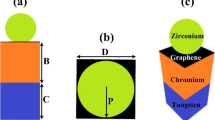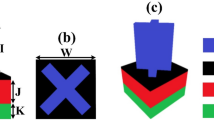Abstract
Throughout history, societies have harnessed renewable energy sources driven by technological advancements and external factors, resulting in the emergence of hydropower, wind turbines, and solar PV, often bolstered by supportive policies and agreements. In the current research, the cylinder-inspired resonator solar absorber (CIRSA) structure has been introduced in optical science. This innovative design, functioning at the nanoscale, achieves exceptional wideband absorption from 200 to 700 nm, a challenge given Earth’s limited wavelength spectrum. Impressively, it attains a 98.71% solar energy absorptance within this range, with notable peaks at 490 nm (98.99%) and 500 nm (98.71%) in the solar thermal wavelength band, maintaining high absorption across angles from 0 to 80° for both TE and TM polarizations. Moreover, this cylinder-inspired solar thermal energy absorber effectively minimizes solar energy losses and ensures a high Air Mass Index (AM 1.5), although a significant reduction in AM 1.5 is observed beyond 700 nm. As a part of this world-breaking research project, a cylinder-inspired gold resonator is also introduced. It includes a Gallium-Arsenide (GaAs) substrate and chromium (Cr) ground. It led to the development of efficient solar heaters for air and water systems, opening up significant opportunities for solar energy harvesting.










Similar content being viewed by others
Availability of Data and Materials
The data supporting the findings in this work are available from the corresponding author with reasonable request.
References
Olabi AG, Abdelkareem MA (2022) Renewable energy and climate change. Renew Sustain Energy Rev 158. https://doi.org/10.1016/j.rser.2022.112111
Kalogirou SA (2004) Solar thermal collectors and applications. Prog Energy Combust Sci 30(3):231–295. https://doi.org/10.1016/j.pecs.2004.02.001
Wang C, Li W, Li Z, Fang B (2020) Solar thermal harvesting based on self-doped nanocermet: Structural merits, design strategies and applications. Renew Sustain Energy Rev 134. https://doi.org/10.1016/j.rser.2020.110277
Sayed ET et al (2023) Renewable energy and energy storage systems. Energies 16(3). https://doi.org/10.3390/en16031415
Al-Shahri OA et al (2021) Solar photovoltaic energy optimization methods, challenges and issues: a comprehensive review. J Clean Prod 284. https://doi.org/10.1016/j.jclepro.2020.125465
Wang J et al (2021) Universal strategy to prepare a flexible photothermal absorber based on hierarchical Fe-MOF-74 toward highly efficient solar interfacial seawater desalination. ACS Appl Mater Interfaces 13(38):45944–45956. https://doi.org/10.1021/acsami.1c11176
Almawgani AHM et al (2023) Structural investigation of ultra – broadband disk-shaped resonator solar absorber structure based on CNT – TiC composites for solar energy harvesting. Int J Therm Sci 192:108414. https://doi.org/10.1016/j.ijthermalsci.2023.108414
Szunerits S, Maalouli N, Wijaya E, Vilcot JP, Boukherroub R (2013) Recent advances in the development of graphene-based surface plasmon resonance (SPR) interfaces. Anal Bioanal Chem 405(5):1435–1443. https://doi.org/10.1007/s00216-012-6624-0
Jiříčková A, Jankovský O, Sofer Z, Sedmidubský D (2022) Synthesis and applications of graphene oxide. Materials 15(3). https://doi.org/10.3390/ma15030920
Wu J, Lin H, Moss DJ, Loh KP, Jia B (2023) Graphene oxide for photonics, electronics and optoelectronics. Nat Rev Chem 7(3):162–183. https://doi.org/10.1038/s41570-022-00458-7
Huang M, Wei K, Wu P, Xu D, Xu Y (2021) Design of grating type GaAs solar absorber and investigation of its photoelectric characteristics. Front Mater 8. https://doi.org/10.3389/fmats.2021.781803
Patel SK, Agravat D, Alsalman O, Surve J, Taya SA, Parmar J (2023) Numerical analysis of wideband solar absorber using thick film with glassy material, resonator and back reflector. Opt Quantum Electron 55(9):754. https://doi.org/10.1007/s11082-023-04982-8
Rinnerbauer V, Shen Y, Joannopoulos JD, Soljačić M, Schäffler F, Celanovic I (2014) Superlattice photonic crystal as broadband solar absorber for high temperature operation. Opt Express 22(S7):A1895. https://doi.org/10.1364/oe.22.0a1895
Agravat D, Patel SK, Almawgani AHM, Alsuwian T, Armghan A, Daher MG (2023) Investigation of a novel graphene-based surface plasmon resonance solar absorber to achieve high absorption efficiency over a wide spectrum of wavelengths, from ultraviolet to infrared. Plasmonics. https://doi.org/10.1007/s11468-023-02061-y
Agravat D, Patel SK, Almawgani AHM, Irfan M, Armghan A, Taya SA (2023) Graphite-based surface plasmon resonance structure using Al2O3-TiO2-ZrO2 materials for solar thermal absorption. Plasmonics. https://doi.org/10.1007/s11468-023-01986-8
Alsharari M, Armghan A, Aliqab K (2023) Numerical analysis and parametric optimization of T-shaped symmetrical metasurface with broad bandwidth for solar absorber application based on graphene material. Mathematics 11(4). https://doi.org/10.3390/math11040971
Murugesan N et al (2023) Improving selectivity of thin film solar absorber by cobalt oxide grafted reduced graphene oxide. Opt Mater (Amst) 138. https://doi.org/10.1016/j.optmat.2023.113629
Wu P, Dai S, Zeng X, Su N, Cui L, Yang H (2023) Design of ultra-high absorptivity solar absorber based on Ti and TiN multilayer ring structure. Int J Therm Sci 183:107890. https://doi.org/10.1016/j.ijthermalsci.2022.107890
Khalichi B, Ghobadi A, Kalantari Osgouei A, Rahimian Omam Z, Kocer H, Ozbay E (2023) Phase-change fano resonator for active modulation of thermal emission. Nanoscale 15(25):10783–10793. https://doi.org/10.1039/d3nr00673e
Kalantari Osgouei A, Hajian H, Khalichi B, Serebryannikov AE, Ghobadi A, Ozbay E (2021) Active tuning from narrowband to broadband absorbers using a sub-wavelength VO2 embedded layer. Plasmonics 16(4):1013–1021. https://doi.org/10.1007/s11468-020-01370-w
Osgouei AK, Ghobadi A, Khalichi B, Ozbay E (2021) A spectrally selective gap surface-plasmon-based nanoantenna emitter compatible with multiple thermal infrared applications. J Opt (United Kingdom) 23(8). https://doi.org/10.1088/2040-8986/ac16b7
Buchberg H, Cation I, Edwards DK (1976) Natural convection in enclosed spaces—a review of application to solar energy collection. J Heat Transfer 98(2):182–188. https://doi.org/10.1115/1.3450516
Kabeel AE, Mečárik K (1998) Shape optimization for absorber plates of solar air collectors. Renew Energy 13(1):121–131. https://doi.org/10.1016/S0960-1481(97)00034-7
Patel SK et al (2023) Design of a broadband solar absorber based on Fe2O3/CuO thin film absorption structure. Opt Quantum Electron 55(5). https://doi.org/10.1007/s11082-023-04706-y
Alsaif H, Patel SK, Ben Ali N, Armghan A, Aliqab K (2023) Numerical simulation and structure optimization of multilayer metamaterial plus-shaped solar absorber design based on graphene and SiO2 substrate for renewable energy generation. Mathematics 11(2). https://doi.org/10.3390/math11020282
Patel SK, Surve J, Jadeja R, Katkar V, Parmar J, Ahmed K (2022) Ultra‐wideband, polarization‐independent, wide‐angle multilayer swastika‐shaped metamaterial solar energy absorber with absorption prediction using machine learning. Adv Theory Simulations 2100604. https://doi.org/10.1002/adts.202100604
Elsheikh AH, Sharshir SW, Abd Elaziz M, Kabeel AE, Guilan W, Haiou Z (2019) Modeling of solar energy systems using artificial neural network: a comprehensive review. Solar Energy 180:622–639. https://doi.org/10.1016/j.solener.2019.01.037
COMSOL Multiphysics® v. 6.0
Zimmerman WBJ (2006) Introduction to comsol multiphysics 1–26
Vervuurt RHJ, Kessels WMME, Bol AA (2017) Atomic layer deposition for graphene device integration. Advanced Materials Interfaces 4(18). https://doi.org/10.1002/admi.201700232
Zhang J, Li Y, Cao K, Chen R (2022) Advances in atomic layer deposition. Nanomanufacturing and Metrology 5(3):191–208. https://doi.org/10.1007/s41871-022-00136-8
Hinkle CL et al (2008) GaAs interfacial self-cleaning by atomic layer deposition. Appl Phys Lett 92(7). https://doi.org/10.1063/1.2883956
Qing F, Hou Y, Stehle R, Li X (2019) Chemical vapor deposition synthesis of graphene films. APL Mater 7(2). https://doi.org/10.1063/1.5078551
Mortelmans T et al (2020) Grayscale e-beam lithography: effects of a delayed development for well-controlled 3D patterning. Microelectron Eng 225. https://doi.org/10.1016/j.mee.2020.111272
Agarwal S, Prajapati YK (2019) Multifunctional metamaterial surface for absorbing and sensing applications. Opt Commun 439:304–307. https://doi.org/10.1016/j.optcom.2019.01.020
Hanson GW (2008) Dyadic green’s functions and guided surface waves for a surface conductivity model of graphene. J Appl Phys 103(6). https://doi.org/10.1063/1.2891452
Singh RS, Bhushan S, Singh AK, Deo SR (2011) Characterization and optical properties of Cdse nano-crystalline thin films. Dig J Nanomater Biostructures 6(2):403–412
Air Mass 1.5 Spectrum, American society for testing and materials (ASTM)
Yu P et al (2020) Ultra-wideband solar absorber based on refractory titanium metal. Renew Energy 158:227–235. https://doi.org/10.1016/j.renene.2020.05.142
Yu P et al (2019) A numerical research of wideband solar absorber based on refractory metal from visible to near infrared. Opt Mater (Amst) 97. https://doi.org/10.1016/j.optmat.2019.109400
Liu B et al (2020) Broadband, wide-angle, and polarization-insensitive enhancement of light absorption in monolayer graphene over whole visible spectrum. Results Phys 18. https://doi.org/10.1016/j.rinp.2020.103134
Patel SK, Charola S, Jadeja R, Nguyen TK, Dhasarathan V (2021) Wideband graphene-based near-infrared solar absorber using C-shaped rectangular sawtooth metasurface. Phys E Low-Dimensional Syst Nanostructures 126. https://doi.org/10.1016/j.physe.2020.114493
Funding
The authors are thankful to the Deanship of Scientific Research at Najran University for funding this work under the Research Groups Funding program grant code (NU/RG/SERC/12/2).
Author information
Authors and Affiliations
Contributions
Conceptualization, AHMA and SKP; Methodology, AHMA, and SKP; Software, SP and DA; Validation, SL, AHMA, and YAAA; Writing—original draft preparation, all authors; Writing—review and editing, AHMA and SKP; All authors have read and agreed to the published version of the manuscript.
Corresponding authors
Ethics declarations
Ethical Approval
Not applicable.
Competing Interests
The authors declare no competing interests.
Additional information
Publisher's Note
Springer Nature remains neutral with regard to jurisdictional claims in published maps and institutional affiliations.
Rights and permissions
Springer Nature or its licensor (e.g. a society or other partner) holds exclusive rights to this article under a publishing agreement with the author(s) or other rightsholder(s); author self-archiving of the accepted manuscript version of this article is solely governed by the terms of such publishing agreement and applicable law.
About this article
Cite this article
Patel, S., Agravat, D., Almawgani, A.H.M. et al. Investigation and Analysis of Graphene-Based Surface Plasmon Resonance Solar Absorber Design Using Au-GaAs-Cr Structure for UV and Visible Region. Plasmonics (2023). https://doi.org/10.1007/s11468-023-02156-6
Received:
Accepted:
Published:
DOI: https://doi.org/10.1007/s11468-023-02156-6




